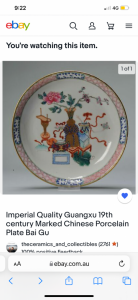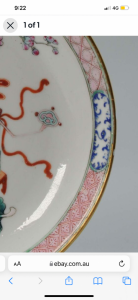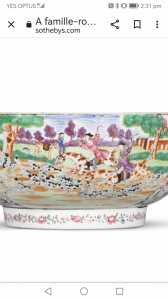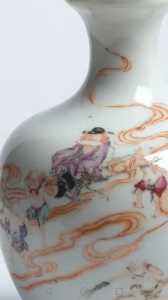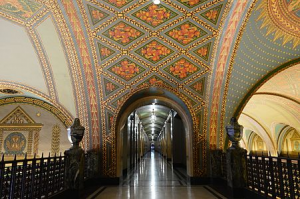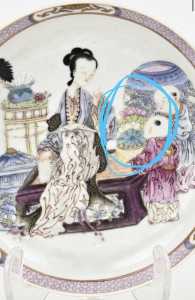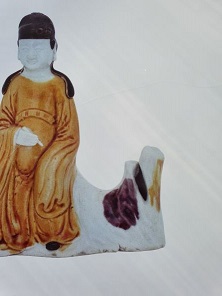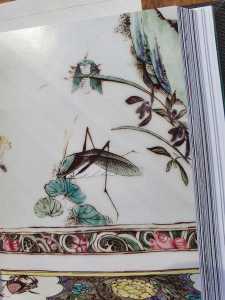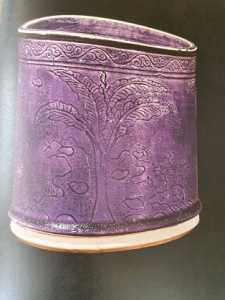The Chinese and Asian Art Forum. For Fans, Collectors and Dealers.
 Basic Rules For the BidAmount Asian Art Forum: Talk about whatever you want. You can even discuss and offer things that are for sale if they are authentic. Maximum image file size per post is 2 MB. Images of 700pxl x 700pxl are optimal if saved at a medium resolution. Be respectful of others and enjoy yourself. Click the YouTube link for a brief tutorial on using the forum. You can also EMBED Videos by cutting and pasting from You-Tube, Vimeo etc.
Basic Rules For the BidAmount Asian Art Forum: Talk about whatever you want. You can even discuss and offer things that are for sale if they are authentic. Maximum image file size per post is 2 MB. Images of 700pxl x 700pxl are optimal if saved at a medium resolution. Be respectful of others and enjoy yourself. Click the YouTube link for a brief tutorial on using the forum. You can also EMBED Videos by cutting and pasting from You-Tube, Vimeo etc.
NOTE: To post an item or add a new post, click open the category title from the FORUM LIST, and CLICK the Blue ADD TOPIC button.
Hello Guys,
appreciate so much your feedback as this has turned out to a very healthy conversation which reflects my own feeling.
I saw this piece when Peter showed Twent Veilinghuis and this product showed up so I thought it was good to go. (yes, i also did saw the mandarin duck as well on the same page.. i believe.)
But I will ask Peter to authenticate the piece.
One of the questions, I would like to ask if why would a modern reproduction do the following:
1.) create a plate only 16.4 cm in diameter when almost with the same effort, he could do a 20.0 cm and sell it at a higher price.
2.) a smaller piece could also mean, a more difficult space to paint. could that be the reason why they cannot get the level of accuracy. the style of painting specially on the edge (roughy compare to the accuracy of Yongzheng of hyper detail).
3.) as pointed out in this healthy post, could there have been imperial kiln imitator during those time. I remember watching those Qing Dynasty movie (Ruyi, royal place) and what the common people do is to follow what is in fashion in the royal court. Could this be one of those "wanna be ceramics" ? Let us say a Minyao version ?
4.) Looking at the back, there seems to be a few firing crack but it looks too clean to me. Would it be good to know if the plate "only" itself if its modern or not ? as Brian pointed out, it doese resemble the highish footrim of a 20th century plate with ladies (which is made much much more elaborately than mine...also bigger in size). The earlier 20th century paste seems dirtier and I think the remnant of Jingdazhen ceramics are based on Jiangxi company and will often be marked with the company name...
5.) lastly, let me imagine I am the faker, can I just get a finished red plate (on a porcelain status) with white inner surface and over enamel it and paint the ladies and rebake it ?
Thanks again guys...
Al
@superox me personally I don’t think of this plate as being a fake modern or republic. To me it’s a copy or authentic of the period. A fake is to deceive I don’t see anything that leads me to think they are deceiving anyone. Etc aging or Yongzheng mark. Not everyone shares this opinion but as for fakes they come in all sizes and shapes.
Hello Guys.
I think I found the border that would be similar to the style.
It is a product being sold by Ceramic and collectable (ebay) the one reommended by Peter.
Here is the photos.
hope this helps the conversation...
It is possible that it is a Guangxu period and perhaps the team can look into the similarity of the enamel...
good night from sydney...
Al
Thanks Brigit for this information....
When everyone is sharing their opinions and ideas every one is learning and emjoying this (not to affordable) hobby...
I have two ladies plate now...so..I will slowly keep collecting ...and enjoying the education...
hope Peter have the same opinion...
Al
I think your border pattern is fine for the 18th c. You see the basic principle ie cartouches with the strips between using various patterns, from Kangxi to Qianlong. Actually, Shangri-la have a Kangxi plate with it - the content is different but the structure of the pattern is the same. In that sense I think yours is fine for a first half of the 18th c plate (which is what I am still inclined to think it is).
If you are referring to the narrowness, that could possibly be to do with the size as it would otherwise mean a cramped central decoration or just because the artist made it like that. You will often see the narrow border on 18th c pieces- and later of course.
Personally don't think the enamels on the front of that particular plate are similar. That doesn't mean there isn't some similarity between the enamels of other 19th c pieces.
I am sure others will have different opinions and as William said, we could all be seeing different variations on our screens. Judging by photos is not infallible, but hopefully Peter will be able to let you know - especially as he flagged it up in the first place.
Hello Ladies and Gents...
I got the reply from Peter.
He said that he has handled this type of ruby back before and even had 2 few expert from a museum looked at it. Both were torn between whether it is a genuine piece or not.
However, according to Peter, the colour of the stool and the purple robe colour looked more like republic.
His prognosis is that this could possibly be a late Qing or Early Republic ware during the revival period of this type of ware and a lot were exported to Europe.
This piece has legitimate wear.
Can anyway, see if this purple colour existed in Yongzheng period ?
But now, we are at a level where even musuem experts and at a crossroad but which ever way, I am happy with it and the learning that comes from this...
Al
From sotheby's. Sold as Qianlong period bowl.
Not exactly the same degree of dark purple.
My vase sold as republican period but probably late 18th century to early 19th century.
Interestingly the early purple appears to be watered down when compared with Republican period.
All very interesting.
Mark
It is also similar to the deep aubergine used on biscuit-glazed pieces.
Hi Mark. Interesting indeed, suddenly I have become more aware of the subtlety in colour. Would the difference in the dye colour a result of (Qianlong using natural pigments...probably from plants... and while the late Qing Republican probably use more chemical based ?)
I also wondered how these products were sold during the Late Qing/Early Republic. Was it sold as a set ? a part of a sauce and cup for tea ?
Could the gold rim and that pattern somethign that is in line with the artdeco feel of the 1900s .... the stiff design signaling advent of industrialisation (less organic and more rigid)....
Or perhaps an exhibition in Europe during that time where this product was sold...
How much would this plate have cost during those period ? (we all wish we have a time machine...and just see those period right ?)
to dream is to be free indeed....
Al
Later, just going out dog-walking. There should be pictures online.
Not 100% sure but I think it artificial or chemical colours used from about 1900 onwards.
The purple was something that I never really thought about until today.
I think you have mistaken the application of organic vs. chemical dyes in oriental rugs or fabrics. Those materials would be be burned to ash if applied to clay and fired in a kiln. The enamel colors on your saucer are based on metallic oxides that were introduced to the Chinese from Europe in the first quarter of the 18th century. These colors are known as ‘famile rose’ in the West, but were called ‘foreign colors’ by the Chinese. They are actually applied in a second firing at a lower temperature after the initial firing of the porcelain body. You can research the term ‘overgraze enamels’ for further information on this process.
Like Mark, I had also not given it much thought, probably because you see purple quite a bit like on purple splashed Jun glazes and aubergine monochromes. To be honest much of the aubergine on the biscuit wares is more of a brown, but I have found some examples of purple tones from 17th/early 18th c. The pictures are from two books A Culture Revealed (Stamen, Volk, Ni) and Sam Marsh's Brush Pots. I added the plate to make it simpler.
There is also a link to a monochrome. The thing is I am not sure if we are sll seeing the exact same shades which makes it difficult. But at least you know purples existed.
https://www.christies.com/en/lot/lot-5418232
Then there is a lighter shade on this plate. This catalogue shows a range of colours (some pieces are later); according to the A Culture Revealed book, there was a lot of experimentation with colours around the Yongzheng period.
Thanks for visiting "The BidAmount Asian Art Forum | Chinese Art"
If you sell on eBay, or have a shop feel free to post images and descriptions and links.
Check back often for discussion about the latest news in the Chinese art and antique world. Also find out about the latest Asian art auctions at Sotheby's, Christie's, Bonhams and Tajans.
Auction results for: fine porcelain, ceramics, bronze, jade, textiles and scholar's objects. As well as Japanese, Thai, Vietnamese and other Asian cultures.
Thank you,
Peter Combs
Topics and categories on The BidAmount Asian Art Forum | Chinese Art
Kangxi vases, Kangxi dishes and chargers, Kangxi ritual pieces, Kangxi scholar's objects, Qianlong famille rose, Qianlong enamels, Qianlong period paintings, Qianlong Emporer's court, Fine porcelain of the Yongzheng period. Chinese imperial art, Ming porcelain including Jiajing, Wanli, Xuande, Chenghua as well as Ming jades and bronzes.
The BidAmount Asian Art Forum | Chinese Art
A free Asian art discussion board and Asian art message board for dealers and collectors of art and antiques from China, Japan, Korea, Thailand, Cambodia, Vietnam and the rest of Asia. Linked to all of the BidAmount Asian art reference areas, with videos from plcombs Asian Art and Bidamount on YouTube. Sign up also for the weekly BidAmount newsletter and catalogs of active eBay listing of Chinese porcelain, bronze, jades, robes, and paintings.
The art of calligraphy - and for the ancient Chinese it certainly was an art - aimed to demonstrate superior control and skill using brush and ink. Calligraphy established itself as one of the major Chinese art forms during the Han dynasty (206 BCE - 220 CE), and for two millennia after, all educated men were expected to be proficient at it.
The Museum’s collections of Asian art span nearly five millennia and encompass the cultures of China, the Himalayas, India, Japan, Korea, and Southeast Asia. In 2007, the Museum launched an initiative to create dedicated galleries for the collection, beginning with a gallery for the arts of Korea ...
Chinese art is full of symbolism, in that artists typically seek to depict some aspect of a totality of which they are intuitively aware.
China Online Museum is the finest online museum of Chinese art. It features Chinese calligraphy, painting, ceramics, bronzes, carving, and other artworks.
Chinese Ceramics & Works of Art. Overview Upcoming auctions Contacts Auction results ... Christie’s sales of Chinese ceramics and works of art showcase centuries of Chinese history. Held throughout the year in London, New York, Paris and Hong Kong, they attract a wide audience of collectors and connoisseurs vying for pieces as diverse as ...
Explore Asian Art Week. Contact the Specialist Department. Chinese Paintings ... Senior Specialist, Head of Sale. [email protected]. Tel:+1 212 641 5760. Bid in-person or online for the upcoming auction:Fine Chinese Paintings on 10 September 2019 at New York. Bid in-person or online for the upcoming auction:Fine Chinese Paintings on 10 ...
Discover an abundance of must-see art from all corners of a vast continent at Christie’s NY Asian Art Week. From contemporary classical and Chinese paintings to works with exemplary provenance from the Art Institute of Chicago, our Rockefeller Paza galleries will be full of ancient treasures and contemporary masterworks in a salute to the vibrant arts of Asia.
Sold to benefit The Art Institute of Chicago’s Asian Art Acquisition Fund, the sale features 84 lots with a focus on Ming and Qing porcelains, and offers a rare insight into the taste for collecting Chinese ceramics and works of art in the Midwest from the end of the 19th century through the 1980s. Highlights include two Wanli wucai garlic-head vases, a Qianlong mark and period, blue and ...
Specialist, Chinese Paintings, Christie's London Dr Malcolm McNeill is a Specialist in Chinese Paintings at Christie’s, based in London. He previously worked as an assistant curator of the Chinese collections and the Victoria and Albert Museum in London, as a researcher at the British Museum, and as a translator and tour guide at the National Palace Museum in Taipei.
The Christie's Education 2020 Conference: The Chinese Art Market 18 Jun 2019 Christie’s Education is delighted to announce our first international academic conference in Asia which will take place in Hong Kong from 26-27 November 2020 at the Hong Kong Convention and Exhibition Centre and will run in parallel with Christie’s Hong Kong Autumn Auctions.
The summer Chinese Art sale in Hong Kong will feature works of art from several private collections, including Qing porcelains and textile from the collection of the legendary Chinese art dealer A. W. Bahr (1877–1959), fine gilt bronze Buddhist sculptures from an old Hong Kong collection, an East Asian collection of Qing dynasty wine cups and jades, and a Japanese collection of Song ceramics ...
Sotheby's Chinese Works of Art Department holds two auctions each year in London, New York, Hong Kong and Paris.
Chinese Art - View Auction details, bid, buy and collect the various artworks at Sothebys Art Auction House.
With more than 340 Chinese works of art dating from the Neolithic to the Republic periods, highlights of this sale include a selection of Qing Imperial monochromes from the collection of Arnold and Blema Steinberg, early ceramics from the Art Institute of Chicago and Chinese porcelain and works of art from the collection of Henry Arnhold.
Results: Sotheby's Asia Week achieved $52.4 million in six strong auctions, exceeding pre-sale estimates. With 76.5% of lots sold and 60.3% of lots surpassing high estimates, the Asian art sales at Sotheby's indicate continued collector interest in the finest works of art from China, India and and the Himalayas.
Today's sale of Important Chinese Art will proceed as planned with sessions at 10 AM and 2 PM EDT. Sotheby's will be monitoring the weather conditions throughout the day and will be available to coordinate alternative bidding options should conditions make it difficult for clients to attend the auction in person.
Bonhams Chinese Art department is renowned for offering the finest works of art representing the richness and breadth of China's artistic heritage, particularly Imperial porcelain, white and spinach green jades, cloisonné and Buddhist art. Specialised international auctions are held globally, including London, Hong Kong and San Francisco.
Bonhams : Chinese Works of Art We use cookies to remember choices you make on functionality and personal features to enhance your experience to our site. By continuing to use our site you consent to the use of cookies. Please refer to our privacy and cookie policies for more information.
Bonhams Fine Art Auctioneers & Valuers: auctioneers of art, pictures, collectables and motor cars. We use cookies to remember choices you make on functionality and personal features to enhance your experience to our site. By continuing to use our site you consent to the use of cookies. ... Chinese Art (US) General enquiries
Bonhams : Fine Chinese Art We use cookies to remember choices you make on functionality and personal features to enhance your experience to our site. By continuing to use our site you consent to the use of cookies. Please refer to our privacy and cookie policies for more information.
Bonhams Fine Art Auctioneers & Valuers: auctioneers of art, pictures, collectables and motor cars Bonhams : Asian Art We use cookies to remember choices you make on functionality and personal features to enhance your experience to our site.
Bonhams are international auctioneers of fine Chinese and Japanese art. We specialise in rare Imperial and Export Chinese ceramics and works of art, as well as Japanese ceramics, fine and decorative works of art from the Neolithic Period to the 20th century. View on map
Bonhams Fine Art Auctioneers & Valuers: auctioneers of art, pictures, collectables and motor cars. We use cookies to remember choices you make on functionality and personal features to enhance your experience to our site. By continuing to use our site you consent to the use of cookies. ... Asian Art Bonhams. Work. 22 Queen St.
